How To Build And Launch A Digital Brand (Complete Guide)
You have an idea about this great thing you want to create. As you think about it more, it actually sounds great, and you want to bring it to life.
The first question you’re probably asking yourself is, Where do I start?
With this guide, I will show you how to organize all your thoughts and transform them into something that works for you.
Everything that you need to do for your brand is included in this simple guide. Follow these steps to get started.
The goal is to give you perspective, and a better understanding of where to start and what to do next.
You can also download the guide as a PDF and save it for future use.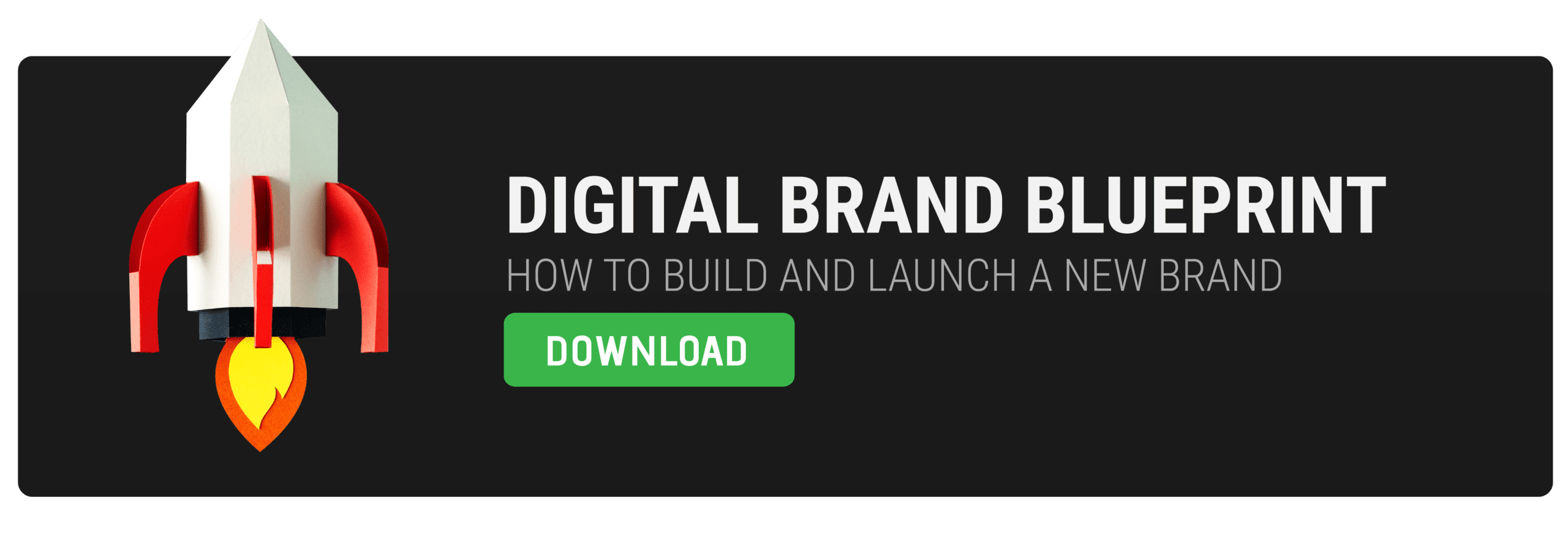
A brand is the combination of many elements and factors that contribute to the way a business is recognized by the public. That includes brand purpose, visual style, value proposition, and more.
Digital branding is the process of creating a connection with potential consumers online. That happens through storytelling, the use of visuals, and other techniques that increase awareness about the identity of a business.
Your Brand Identity
There are several elements that form a brand identity, and they all fit together like a puzzle. I divide them into three parts, visual elements, story elements, and value elements.
Story elements include your mission, vision, and brand story. Let’s take look at how you can use each one to build on your identity.
1. Name your brand
Names are everything. Choosing a name for your brand can feel like the most important thing when you start building a business.
Yes, the name is important when it comes to leaving a good first impression. That’s why your brand name should be simple and memorable.
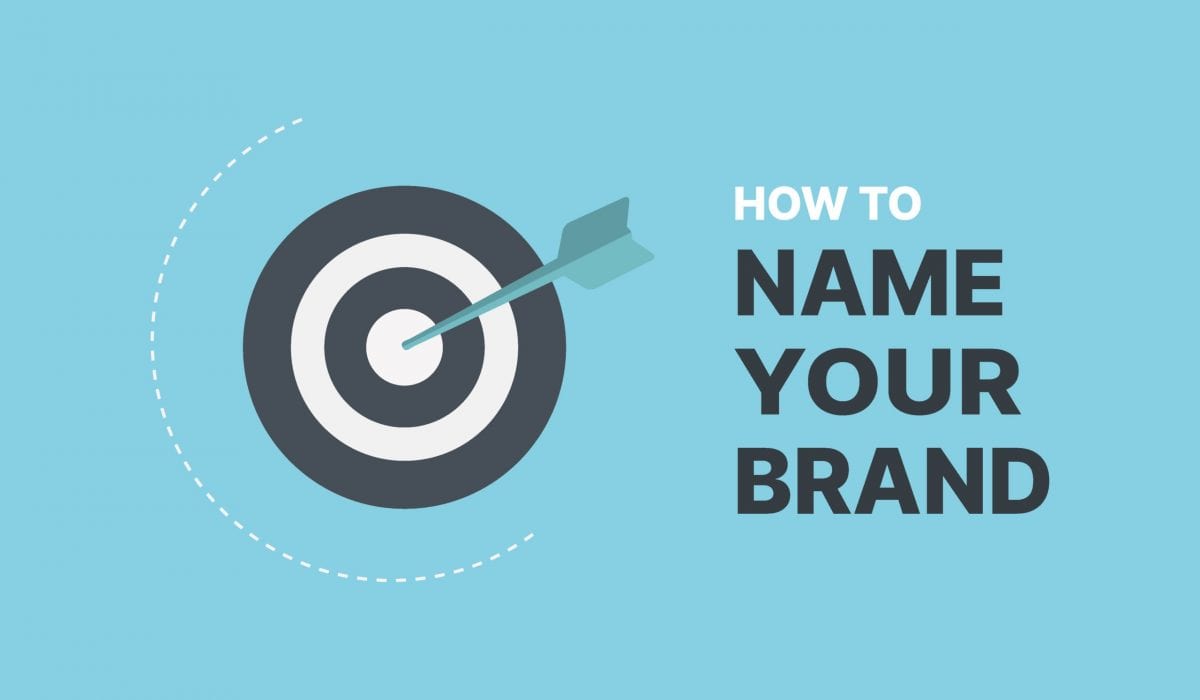
Coming up with a brand name
Here is how to start brainstorming about your new name. Think about the goal of your idea and what you want to accomplish with it. What is the goal of your name?
Here are some common types of names:
- Personality names introduce the person behind the business.
- Descriptive names indicate the types of products and services you offer.
- Acronym names are first letter acronyms of the organizations. ( For example, UNICEF )
- Geographic names are usually based on the location of your business.
- Compound names put together or combine the meaning of two or more words.
- Wordplay names get created by misspelling or rhyming words.
Brand Name Example: YouTube is the most popular video streaming platform. Its name comes from combining two words.
You as a person uploading videos and Tube as an old acronym for television. The original tagline of YouTube is “Broadcast Yourself”.
The Name Game
Here is an exercise that I found when I needed some help with naming this website.
📝 Create a list of 50 keywords that represent your brand and are related to the topic. This list can help you when you’re choosing your name.
Grab a pen and a piece of paper. With your idea in mind, start writing down keywords that you think can describe the brand that you want to build.
Start brainstorming ideas and combining words from your list. Finally, narrow it down to your best options and choose one.
2. Define your brand purpose, mission, and vision
There are many, many digital brands out here, so naturally, we’ve started to pick and choose what we follow, use, and support. That is why it is important for your followers to connect with your purpose.
The purpose of your brand ties together the value you provide with a stronger meaning behind it. It will help drive your brand behind the scenes, but it will also let people know what you stand for.
If your brand is a shiny new car, then your purpose is the engine inside. It constantly drives your brand forward.

To communicate the purpose behind your brand, you can create a mission and a vision statement.
Brand Vision
The vision part defines your aim for the future. It is everything that you’re working towards and all the goals you’re trying to achieve.
It will remind you everyone that is a part of your brand in some way of what you’re working for. It will keep motivating you to achieve what you set out to do when you started your business.
💬 What do you want to accomplish with your brand?
Brand Mission
The mission part outlines your purpose, and who you are. Think of it as a description of what you do, and what your brand stands for.
💬 How does success look for you? One year from now? Five years from now?
Brand Story
Your audience needs to know and understand who you are, to connect with you. An interesting story always hides behind the brand, and if you have one you should tell it to the world.
💬 What to consider when crafting your story:
- Where and how did your journey begin
- What stories and experiences can you share
- What lessons have you learned along the way
Share the good and share the bad. We’re all human, and people need to see that to connect with someone.
💡 Write down a mission and a vision for your brand. Think of them as a map of where your brand stands now, and where it’s headed.
The Visual Brand Elements
The visual brand identity is a combination of visual elements that are used to express the purpose, mission, and value of a brand to its consumers.
That usually includes brand colors, a logo, fonts, visual language, and content display.
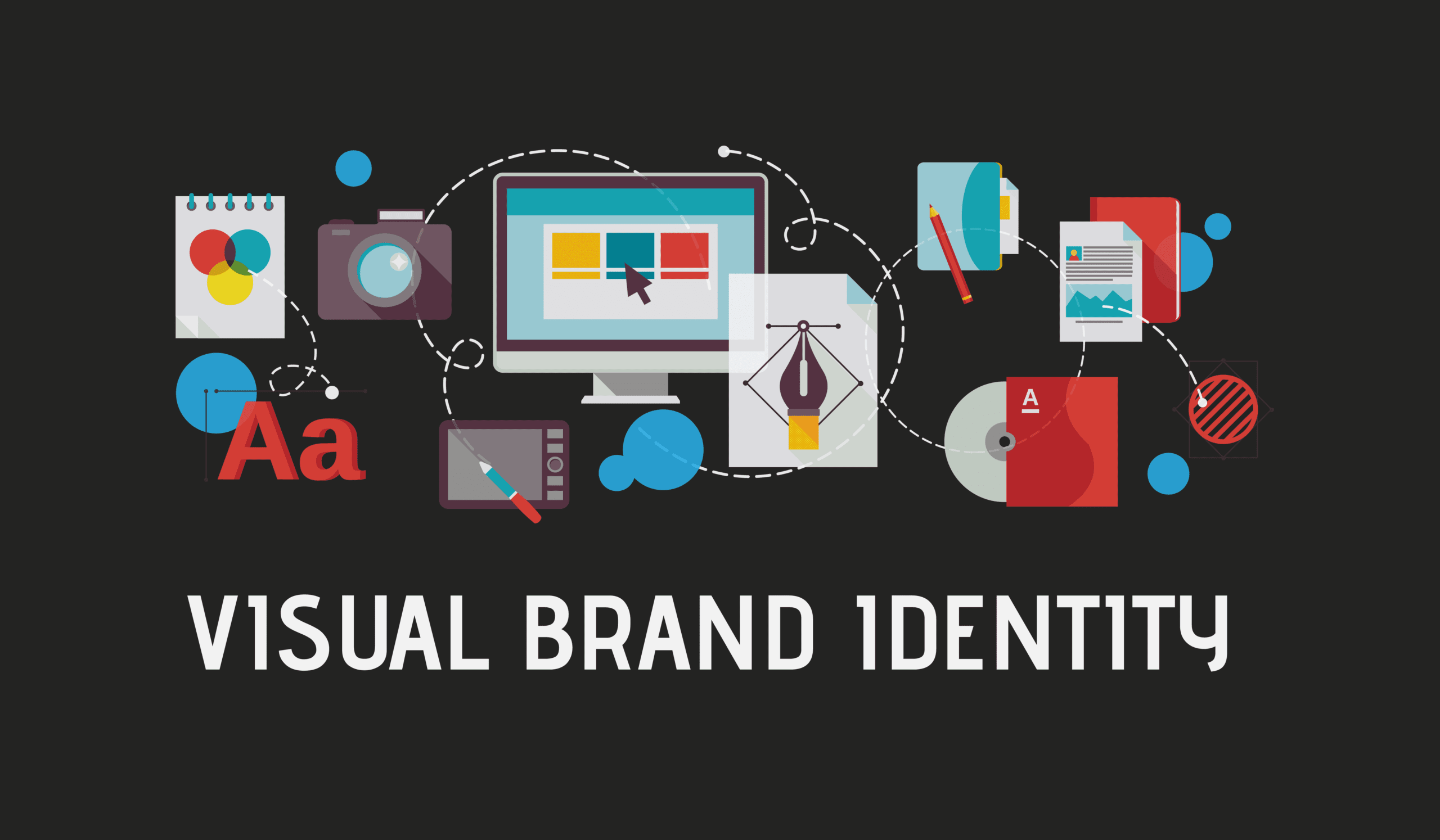
Since it is the first thing that people get in contact with, here are a few things that a well-designed visual identity should successfully get across to potential consumers:
- Visually communicates the brand purpose and values
- Makes the brand stand out with a unique style
- Makes the brand easily recognizable
- It’s well set-up and pleasing to the eye
- It’s consistent across all products and channels
The most successful brands offer high-quality products and services to begin with. The visuals and packaging are an additional feature that increases the value even more.
3. Choose your brand colors to showcase your style
Let’s start by talking about the colors of your brand because they can easily set the mood right from the start.
When we see a color, our brain automatically attaches a specific meaning or emotion to it.
For example, you are probably familiar with the use of green color to confirm, or red color to cancel an action in most user interfaces.
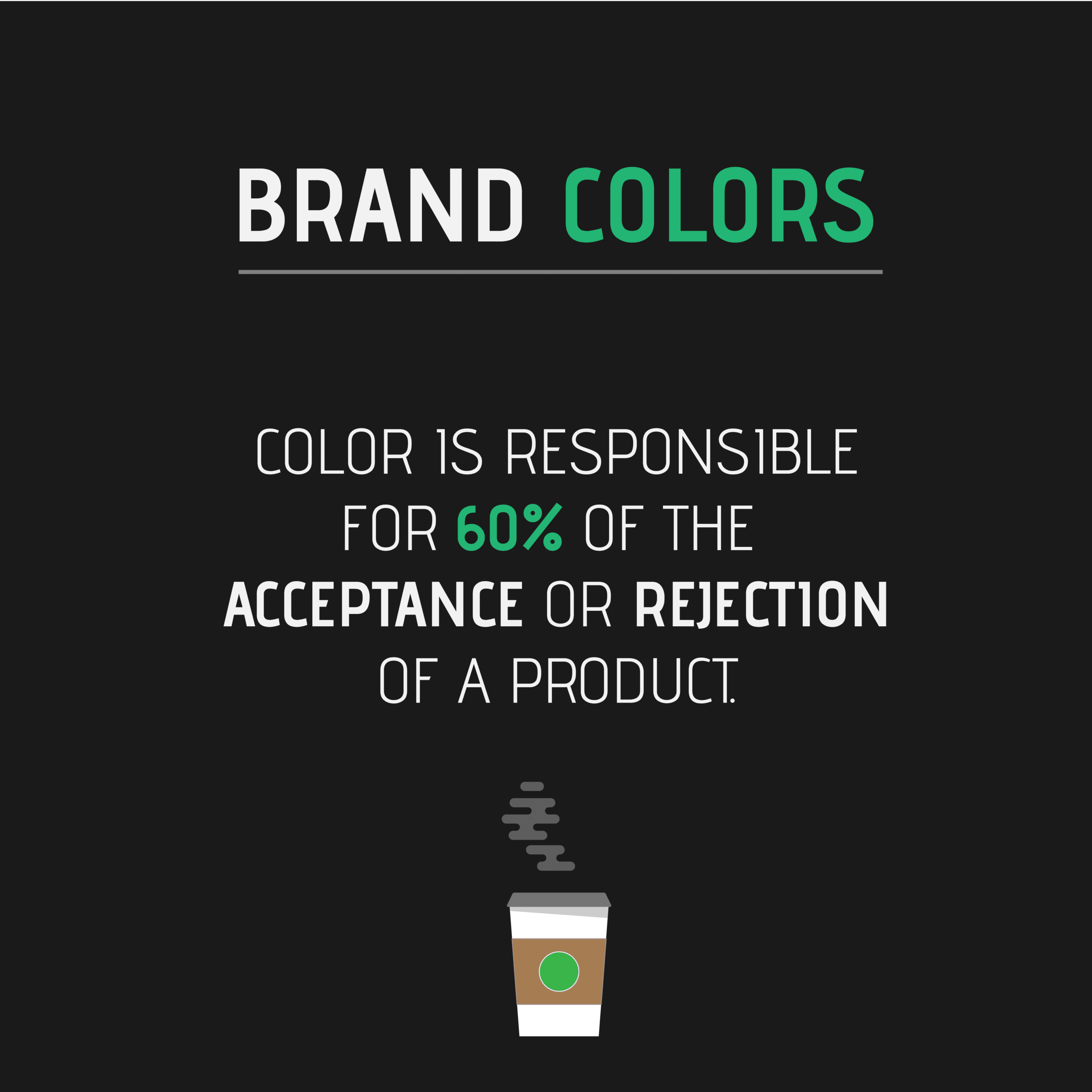
Different combinations of colors come together to deliver a more complex and aesthetically pleasing presentation of the brand. You can read more about choosing combining colors in this color harmony guide.
Brand Colors Example: Coca-Cola has an easily recognizable color scheme across all its digital channels. It uses bright red to inspire excitement in its customers.
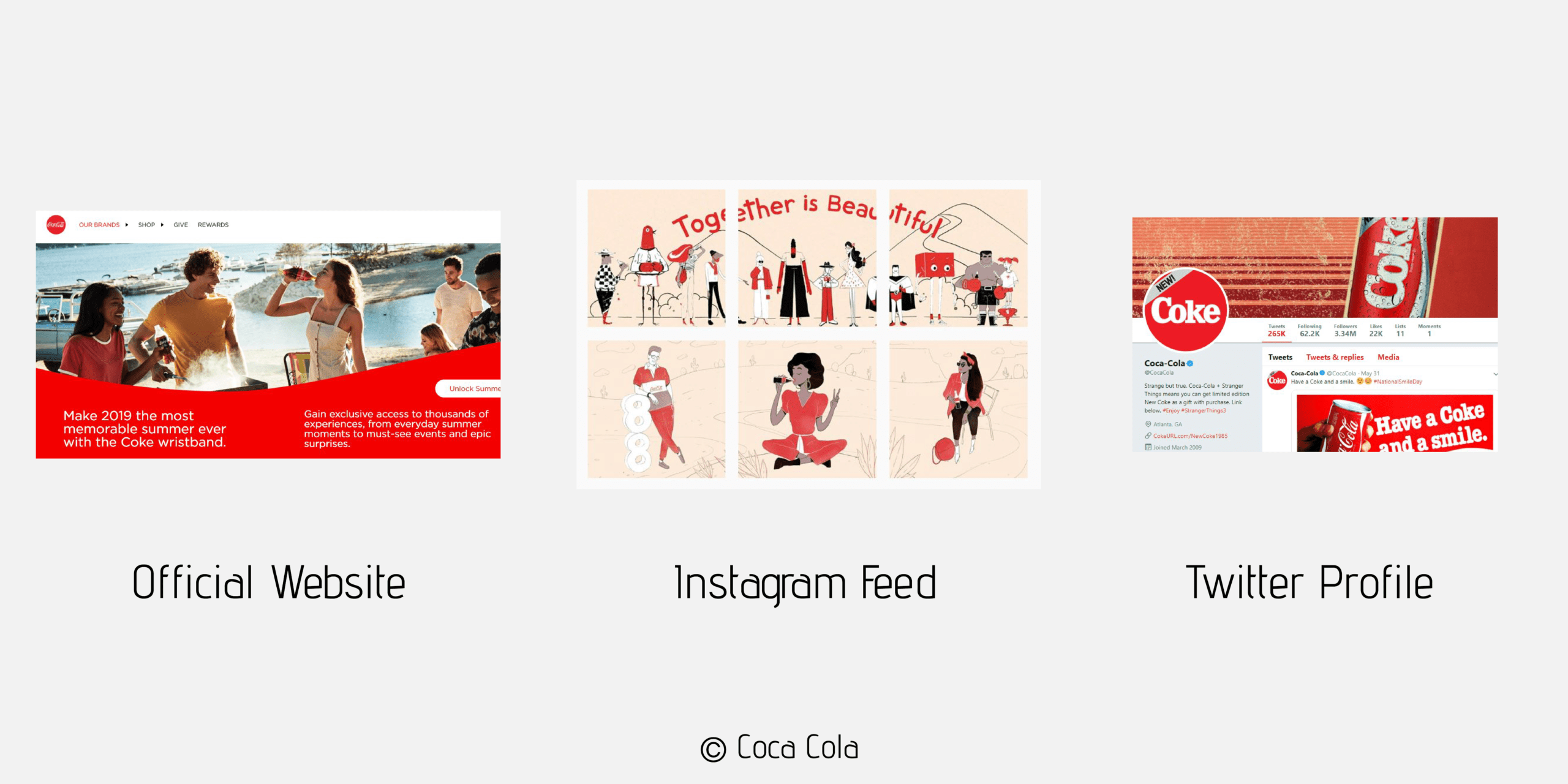
🖌 Start working on your visual identity by choosing the right colors and harmonies to represent your brand and the feeling that you want to inspire in people that will be using your products or services.
4. Design a brand logo to introduce your business
Moving on to the logo of your brand, I often see it as an equivalent to a profile picture. A good logo should be representative of the brand and always recognizable by the consumer.
It is important to have a logo that fits in the modern world and the industry that the brand is in, as it is a vital asset in brand perception by consumers.

Depending on the type of brand, there are different logotypes, that might work for different purposes.
7 Logotypes that you can use for your brand:
- Word-mark logos
- Letter-mark logos
- Abstract logos
- Pictorial logos
- Mascot Logos
- Emblem logos
- Combination of multiple styles
👁🗨 Go back to your list of 50 keywords connected to the brand, sketch out a few ideas based on them. See what seems to work the best, and decide on the final version based on that. You can design a logo by yourself or you can use a professional designer.
Please note that links in this article take you to the official web pages of these tools using my affiliate link. Including Envato, Namecheap, Grammarly, and Sendinblue. That means if you like the products and decide to make a premium purchase I might receive a small commission in return. This comes at no extra cost to you, of course. On the other hand, it helps me create more free content like this on the Digital Brand Blueprint website.
 All the Logos you need and many other design elements are available for a monthly subscription by subscribing to Envato Elements.
All the Logos you need and many other design elements are available for a monthly subscription by subscribing to Envato Elements.
This gives you unlimited access to a massive and growing library of 1,500,000+ items that can be downloaded as often as you need (stock photos too)!
A good way to come up with a logo idea is to think about the keywords that best represent the brand, together with the feeling you want to inspire in people.
Logos are a way for brands to mark their territory, to tag their content, and their products. Your logo should:
- Capture the brand name and message
- Use colors that represent the desired emotion
- Think about placement across different materials
- Keep it clean and simple
- Represent your brand accurately
5. Stylize your visual identity to become easily recognizable
There are many ways that a brand can visually express its identity, purpose, and intent.
The visual elements can include typography, icons, data presentation, photos, videos, motion graphics, and so on.
Putting it all together, the logo, the colors, and all other visual elements should come together and form a style that is unique to your brand. Of course, that can mean a lot of different things.
Find a way to capture the personality of your brand and transfer it into the content and products that you produce.
How to Build a Visual Identity of a Brand (Checklist)
- Choose the right colors that inspire emotion
- Design a logo that represents the brand value
- Use custom typography and fonts
- Use visual elements to communicate the brand purpose
- Bring it all together with a unique style
- Create a visual asset library with all your elements
- Stay consistent across all channels
📁 Put together a mood board with pictures that represent the feeling that you want to give to people. Use the mood board as a style guide for your brand.
Your Target Audience and Customers
When it comes to increasing your audience, it’s not always about the number of people that see your ad, or even the amount of people that follow you.
Instead, the focus should be on getting your brand, message, product, or service in front of the right people for your brand.
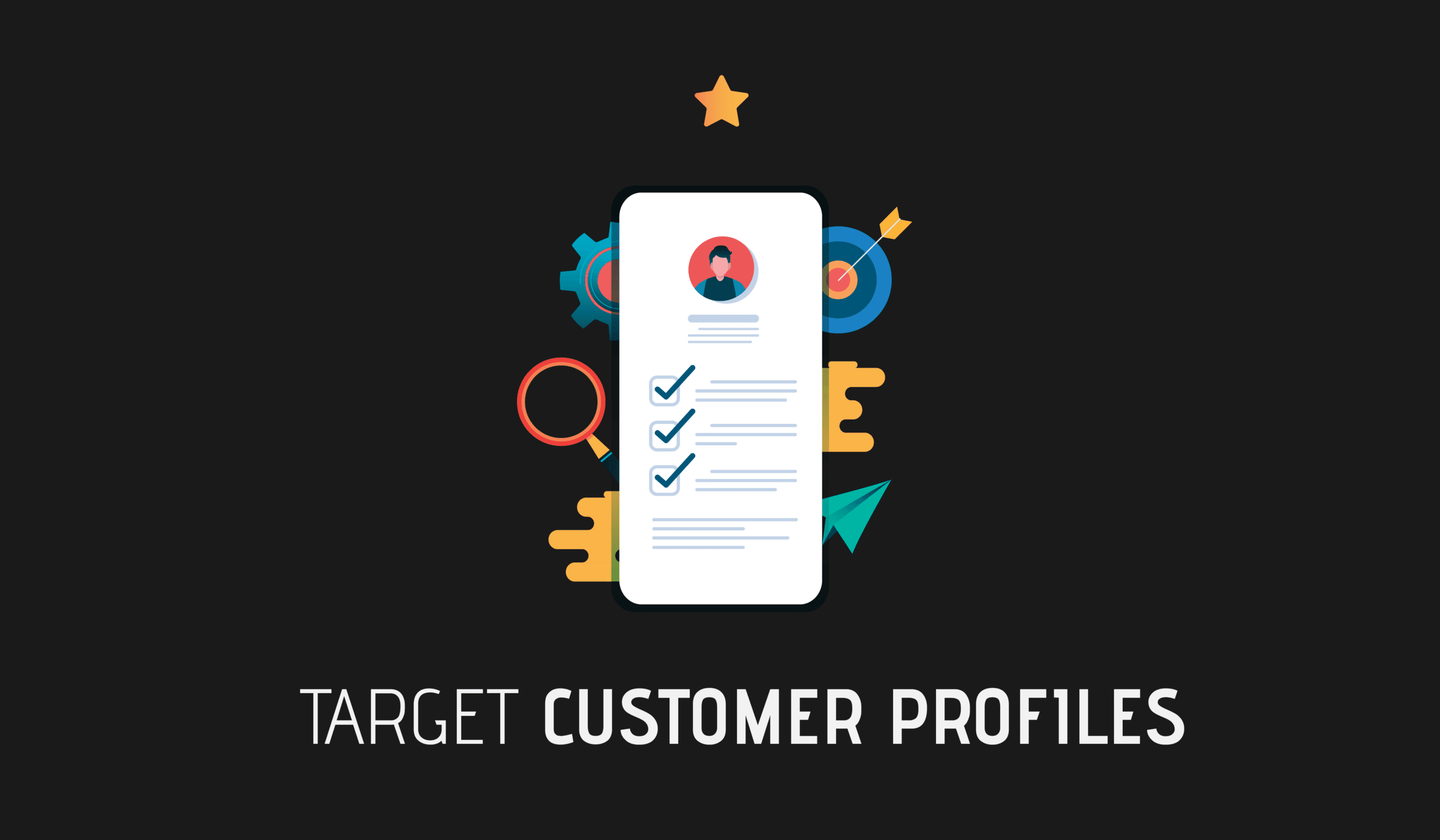
6. Create target customer profiles
There is a simple way to get inside the mind of a potential customer. We do that by creating target customer profiles to describe our potential consumers.
There is usually more than one type of customer you’re targeting so your brand might need a few audience profiles.
What is a customer profile?

In a nutshell, a customer profile is all the information a brand has on their ideal customers. That includes demographic and behavioral data about the people that the brand is targeting on the market.
You can put together target customer profiles by doing market research and direct communication with potential customers.
I will show you how you can go beyond simple demographics to create an ideal customer profile for your business.
Outline customer demographics
The first step in creating a profile of a target customer is to outline all the characteristics that are relevant to the target audience.
Customer characteristics can serve as a foundation for you to start building your ideal customer. You start off simple and go into more details in later steps.
Something important to understand is that not every single person that becomes your customer will fit this profile. You’re creating profiles to get an idea of what the large group of customers will look like.
Demographic data describes the various characteristics of your audience. It is usually the first step that brands take toward strategic customer targeting. Here are common demographic data examples:
- Gender
- Age
- Marital Status
- Income
- Profession
- Net Worth
- Location
- Nationality
- Religious Affiliation
- Political Affiliation
👥 Create a profile with demographics that fit a large portion of your target audience. Narrow down their age, location, income, education, job title, gender, or anything else that is useful for your brand to know.
7. Create a map of the customer journey
When you have a clear picture of how they spend their time and attention during the day, it will become easier to find a place for your brand in their lives.
You need to fit into their routine and help them by making the problems that they face daily easier to solve.
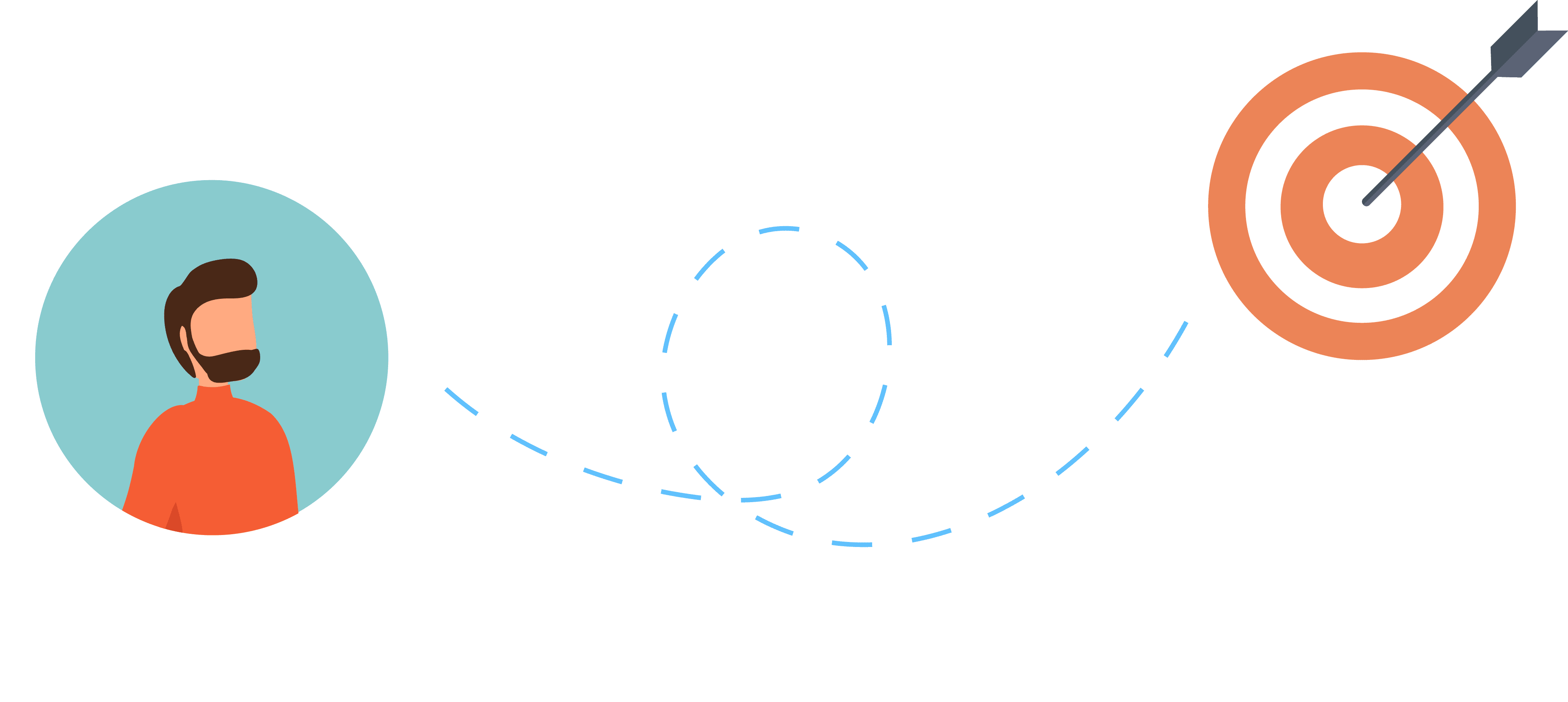
How does the lifestyle of a target customer look?
Walk a mile in their shoes. Consider the things they face and get into as much detail as you can find. Here are some questions you need to answer:
- A typical day for your target audience
- Activities do they enjoy in their free time
- Something they need to make life better
All of that is important because when you know the regular things that the target does, it is easier to see the problems that they might face.
What problems does a target customer face?
We use products, services, and social interaction to somehow improve our standing in the world. Therefore, we consume the things that we believe will do the best job in doing so.
Engage with communities in your target market. Communicate with your potential customers and discover the many ways you can help them.
Find problems, big and small, that your target audience is facing, and you can help solve for them.
What are their goals?
Your brand is here to help customers improve and reach their lifestyle goals. Think about the things that they’re trying to achieve and how your product or content fits into that.
Having an insight into their goals will help you speak to them when you’re promoting your services or creating content for them.
Spend some time researching the behavior of your potential audience.
🗺️ Note the different moments where your brand can step in and help the target audience. Map out the customer journey.
Your Place In The World
One of the goals of your brand is to monetize your work in some way and provide sustainability. You need to earn money so you can support yourself and stay creating what you love.
So far, you’ve worked on establishing who you are, and what your brand represents. Now, we should move on to finding your place in the world.
Many digital brands can move into more than one direction, and you can always mix and combine different business models. However, I suggest you focus on just one model at the start and possibly expand in the future.
8. Choose a business or monetization model
In this next step, think about what you do to serve your audience.
Before you start brainstorming about ways that you can serve your audience, I want you to start with a question in mind.
How much money do you need to earn to be comfortable and free to create your work?

The way you monetize your work should make sense for your audience. For example, if people follow you for fitness advice, they expect you to be affiliated with fitness products or services.
Here are ways that you can monetize your personal brand:
- Affiliate promotions
- Brand deals and collaborations
- Placing advertisements on your content
- Offering digital information products
- Selling physical products
- Consulting and coaching people
- Creating a subscription-based offer
I suggest that you focus only on one monetization model to begin with. As your audience grows, you can begin to introduce multiple ways to monetize.
9. Research the market for opportunities
The internet has billions of users, so you’re bound to enter an industry where established personalities are already present. That means you have to find a way to differentiate yourself and build a novel personal brand.
Each market works on the basis of supply and demand. For example, if you’re creating an e-book or a course about mathematics that you plan to sell, then you need to spend some time researching the market before you step in.
You can do that by using the power of search engines by observing and researching relevant topics. 
- How many people are currently offering the same thing as you?
- What do most of the existing offers include?
- Are there enough people out there that are looking for online help?
Once you have your questions ready, start searching for your answers. Look through niche websites, forum discussions, question boards, and even ad postings.
You can write down notes and learnings that will help you form your brand offer.
10. Think about competitors and positioning
The type of market that you’re entering will most likely be a competitive one. That means, there are many people and brands, offering the same thing you are.
That is where your market research comes in handy. Think about the information you collected, and how it serves your brand.
- Does your brand stand out from the competition?
- Is there something people are looking for, but nobody offers?
- How can you be different than everybody else?
- What do you bring to the table that your competition doesn’t?
Bring Your Brand Online
Online presence is key to the success of your brand. It doesn’t matter if you own a local business if you are looking to promote your services.
Why? Because this is a space where you are in control, and where you decide on what to share.
There are millions of pieces of content uploaded to the internet each minute. That means that your brand needs to stand out in some way to get noticed.
11. Create a brand website
This is the beginner’s guide to creating your first website. We will go over all of the checkpoints that you need to publish a website.
If you already have a website set up, you can move on to the next step. How to get your brand website:
- Choose and register a domain name
- Pick a hosting provider to keep your website online
- Install WordPress or other Website Builder
- Edit and create your website content
- Publish your website and share it with people

Namecheap
The domain and hosting provider of the Digital Brand Blueprint website. With the help of Namecheap you can bring your brand online for an affordable price.
I recommend WordPress because they have an easy to understand platform. They are always available to answer my questions and help via live chat, as well.
📦 Fast WordPress Website | Free SSL | Live Chat Support | + Much More
See Packages💻 Register a website where you can post your brand content.
The process depends on the host that you choose to create your site with. If you visit Namecheap you can look for their support documents on how to do the things described above.
12. Create social media profiles for your brand
Think about where would your target audience hang out? Your people might be hanging out on forums, Facebook groups, they might be scrolling through Instagram, watching videos on YouTube and so on.
Part of your branding strategy is to figure out a way to reach those right people, by using the right platforms and channels.

Platforms are the foundation on which you can build your brand presence, such as the web, phone apps, social media, and gadgets.
Channels serve as a more direct means of communication and include email, advertising, search engines, chatbots, phone, and more.
Make sure you know where your audience hangs out online, so you don’t miss out on potential opportunities to connect with them
Similarly, make sure you’re not wasting your time on platforms that don’t work for your brand and have low returns.
Optimize your social media profiles
A good profile will help users understand what your brand stands for and how you will help them if they click follow.

- Choose a username that reflects your brand name. If the original is already being used, you can get creative and go for something that still shows what your brand is.
- Go for a profile photo that showcases your identity. The profile icons on Instagram are small so you need to make sure that the profile photo you choose looks good on smaller sizes.
- The bio description is important as well. Describe your brand in a couple of sentences o, and you can use emojis and hashtags that are connected with your page.
- Enter a website where people can look for more information if they are interested.
- Enter an e-mail or a phone number where people can contact you.
Your profile can be the ultimate business card. It’s the place that needs to be perfect because it offers a big opportunity for converting users to followers.
📣 Create social media profiles on the social platforms that are relevant to your brand. Join communities where you can make an impact and share our brand with others.
Growing Your Brand
Trying to build a brand without a strategy behind it, is like leaving everything to simple chance or luck. You need something that will guide you to success.
You’ve already done some preliminary work with your target audience research, so now it’s time to place a strategic approach behind it. Consider the following:
- How to reach them at different moments
- How to present your brand to them
- How to market to them
- How to hook them and keep their attention
- How to reach a high conversion rate
There are many opportunities for your brand to fill in the blank by making sure that you provide the right content, product, or solution to people.
In this next part, I will talk about growing your brand through content marketing, brand campaigns, and sponsored ads.
13. Create brand content to attract an audience
A content marketing strategy makes it easy for a business to stay organized, and to deliver their brand message by using the right marketing channels.
It sets the direction in which the brand will move, in order to improve the long-term positioning and credibility of the brand.
Three goals for your content marketing
There are three content marketing areas that every brand should plan for: to streamline content, establish authority, and maximize reach.
- To streamline content production. That means, to effectively and efficiently produce more content from less input. It’s all about decreasing the time and money spent to produce content while maintaining its value and quality.
- To establish authority over a subject. Earning authority over specific topics in your market will improve the relationship that your potential audience/consumers have with your brand. That means that your content should repeatedly inform them, answer their questions, and solve their problems.
- To maximize reach and increase awareness. One of the most important roles of content marketing is to present content to your current audience. And at the same time, to keep the flow of consistently bringing new people in the loop.
How to create a content strategy for your brand
Each brand may have a different process for creating and executing its content marketing strategy, but they all run along the same lines.
There are 6 key steps that play a role in the content strategy, and we will go through them all as a part of this guide.
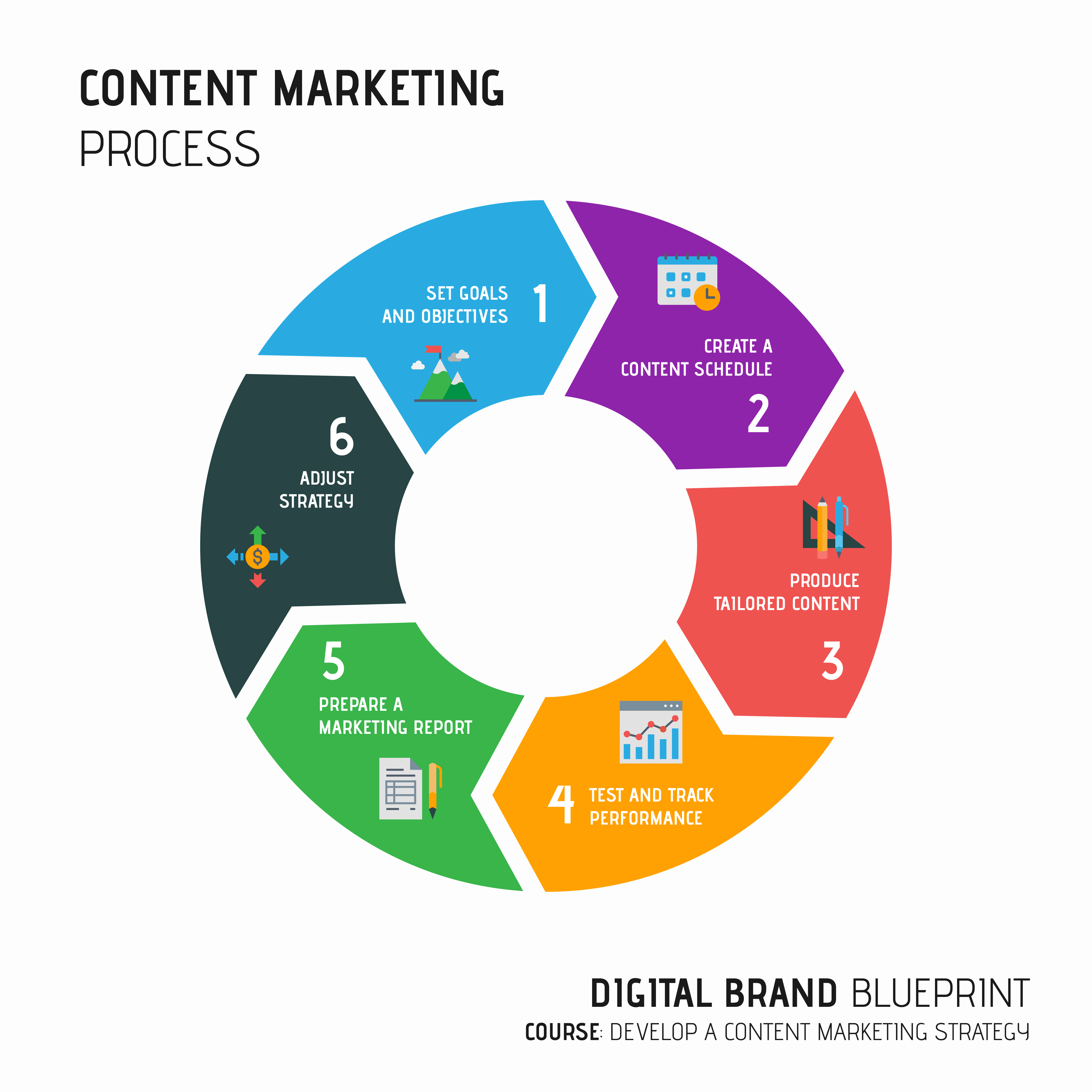
Set content goals and objectives
Document your strategy and goals so you can measure the performance of your content later on.
A popular practice for setting goals is by using the SMART framework:
- Specific: State exactly what you want to accomplish.
- Measurable: Define what metrics will be used to measure progress.
- Achievable: Go for challenging but attainable results.
- Relevant: Make sure the goals help out your marketing strategy.
- Time-bound: Set a period for completing each goal.
Relate your brand content goals to your audience
81% of brand to consumer marketers agree that their organization is concentrated on creating content that builds loyalty, according to recent research done by the Content Marketing Institute.
Content marketers increased spending on brand content creation more so than other areas of content marketing in the last 12 months.
It’s clear that leading brands are investing more time and money than ever, to optimize the experience for their customers.
I describe the concept of alignment as an exchange of value between a brand and its consumers, which ultimately leads to shared gains.

Your strategy can have very specific stages where you want to serve content to your audience depending on your goals, but just as a guide, here are a few common ones:
- Exploring — A person that has not identified the need or problem or they are not aware of an opportunity yet.
- Understanding — A person aware of the need or problem, they understand it, but they don’t have a solution to it yet.
- Comparing — A person that discovered our solution, and they are currently in the process of comparing it to other solutions.
- Engaging — A person that has come back to our solution for further research or interaction.
- Experiencing — A person that is currently using our solution or product.
- Reviewing — A customer that has already used our solution and has some feedback.

Your content goals can include one or multiple of these stages, and each stage has different points of interaction where your brand and your audience can exchange value between each other.
These are the touchpoints where your content marketing strategy comes into play.
Prepare a brand content calendar
A content calendar can help you stay organized and consistent with the content you post.
It makes it easier for you as an individual or a team to keep track of everything that you need to create, as well as when and where it should go out.
Make sure to set the times and dates of your post, the people that will be responsible for making it happen, and the resources you need.
🧩 Prepare a content strategy for your brand. Find the customer journey stages that are relevant to your approach. Create a content calendar to plan the delivery of content.
14. Run marketing campaigns and promotions
A marketing campaign is an essential tool that can help you stay on track with your digital marketing strategy.
Running specific brand campaigns can help you push your brand forward and reach your marketing end goals.
There are many reasons why a brand needs to run marketing campaigns, for example, to introduce new products, to keep a steady stream of new customers, to increase profit, and so on.
A business can also run multiple campaigns at once, to support their marketing strategy and goals.
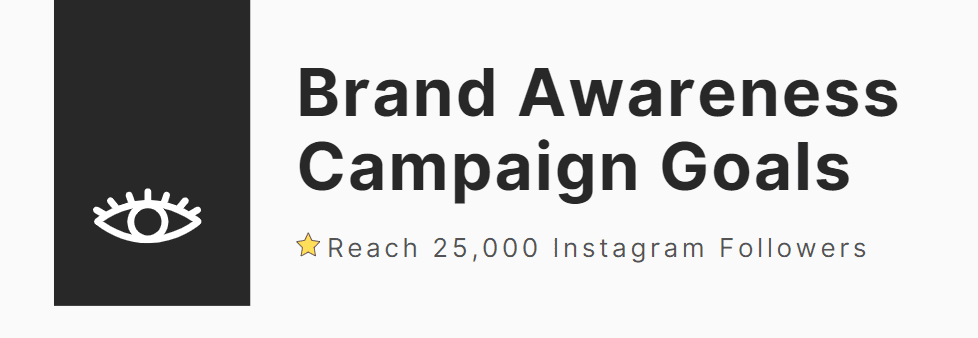
Setting brand campaign objectives
Start by thinking of the desired result of your campaign. What are you trying to accomplish with your campaign?
Most brand campaigns have the goal to increase consumer awareness, reach, or engagement. To improve the chances of success, you need to take things a bit further and go more specific.
With the goal in mind, how exactly does a successful campaign look like? That might go something like this:
- Reach 25,000 followers on Instagram
- Increase our engagement rate on Facebook by 40%
- Collect 170 new e-mail leads for our Newsletter
- Get 50% of online shoppers to visit our physical store
Brand Campaign Timeline and Budget
The costs of a digital campaign can vary a lot. It depends on whether you’re a team or an individual, the available budget, the length and scale of your campaign, and more.
Here are the areas you should consider and make a budget for:
- The cost of resources you need (ex. Cameras, Software, People)
- The cost of sponsored placement
- Any other cost that is relevant to your case
Design promotional materials for your campaign
Once you’re done setting up your campaign behind the scenes, you can move on to creating the specific contents of your promotion. This part is about designing the look and feel of the project.
Here are a few important things to consider:
- The purpose and message behind your campaign
- The value offer that you’re presenting
- The call to action and landing pages
Campaigns usually require more than one piece of content mixed together strategically. Make sure that your message and visuals are consistent across the board.
After the campaign is over, and it is all about analyzing the results, creating notes about key learnings. This will help with decision making on future campaigns easier.
![]()
Envato Elements
All the design graphics and stock photos you need and many other elements are available for a monthly subscription by subscribing to Envato Elements.
The subscription gives you unlimited downloads from a massive and growing library of social media graphics and design assets that can be downloaded as often as you need.
See Subscription PlanBrowse Design Market15. Measure branding strategy performance and adjust when needed
You need to experiment with different types of marketing techniques to find what works best for your brand and audience.
Don’t be afraid to think out of the box with your content to find a way to speak to both groups. Experiment with different types of content and find what works best for your brand and audience.
One of the upsides of producing a large amount of content is that you consequently collect large amounts of data. Don’t let that go to waste.
Tracking the performance will tell you many things about what works, what people think about your brand and what doesn’t appeal to them.

After a set period of time has passed and you’ve collected enough data through tests and content tracking, you should create a report on key findings and the overall success of the strategy.
After some time has passed, you can move on to evaluate everything and to map out the future directions of your content marketing efforts.
Go back to the original goals of your strategy and compare your results.
- What are the key learnings and takeaways from your experiments?
- How does that reflect on your goals?
- What worked and what didn’t? Why?
🎯 After some time passes, make sure to analyze your branding strategy. Create a report on how it’s performing. Finally, adjust your approach if needed.
Bonus: How to start with e-mail marketing
The first thing we do in the morning is check our phones for e-mails, messages, and other notifications. That is the place where most of our communication happens.
It makes e-mail one of the most powerful channels for communication between a brand and its customers.
How can e-mail marketing help with brand promotion?
You can use e-mail to establish a channel of direct communication with your audience or customers. This helps you build a stronger relationship with them.
- It’s an excellent tool for communication with customers
- It can help you grow your business through automation
- You own your contacts, no matter which service you use
Growing a list is beneficial for your brand because it’s something you own no matter what.
![]()
SendinBlue
Sendinblue is a great marketing tool that you can use to start growing your e-mail list for free. If you're subscribed to my list you know that I use it to deliver e-mails.
+ Free to use without a time limit if you’re low on budget
+ Easily create sign-up or subscription forms
+ Build e-mails with a drag and drop editor
+ Create and edit your own automation flows
+ Schedule and send out promotional campaigns.
Start Free PlanRead E-mail Marketing Guide5 Tips for growing your e-mail subscribers list

Here are five ways you can start growing your e-mail list right away:
- Get in touch with people that you already know and might be interested in your updates.
- Add sign-up forms to your most visited pages where people can join for more content from you.
- Post a call to action on your social media profiles and invite your followers to join.
- Create and offer something in return for people that join your list. (For example, ebook, case study, training, course, etc.)
- Reach out to people from your community on the web and social media, and direct them toward your content or offers.
What to do next?
Building a brand is a creative process that requires time and work. Find a way to adjust these steps as it fits your specific needs and purposes.
If you need more inspiration, take a look at the full Digital Band Blueprint post archive.
🚀 You can find more Tools and Resources that will help you build a brand on the Digital Brand Blueprint.
How to Build and Launch a Digital Brand (15 Steps)
Choose a suitable name for your brand.
Define your brand purpose, mission, and vision.
Choose your brand colors, to showcase your style.
Design a brand logo to introduce your business.
Stylize your visual identity to become easily recognizable.
Create target customer profiles to describe your ideal customer.
Create a map of the customer journey to identify relevant stages.
Choose a business or monetization model for your brand.
Research the market to discover opportunities.
Think about competitors and brand positioning.
Create an engaging website for your brand.
Create social media profiles for your brand.
Create brand content to attract an audience.
Run marketing campaigns and promotions to increase brand awareness.
Measure branding strategy performance and adjust when needed
